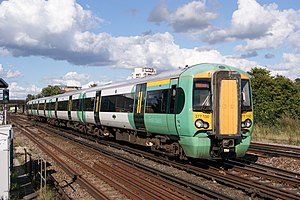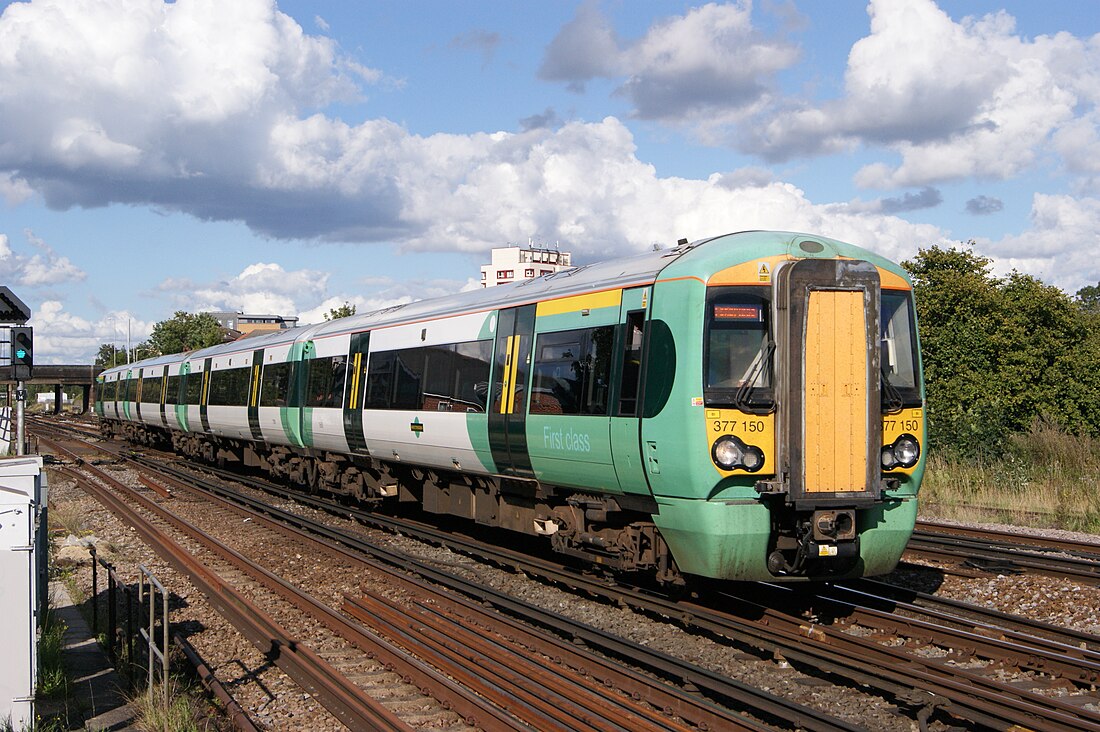The Bombardier Electrostar (sold as the ADtranz Electrostar until 2001) is a family of electric multiple-unit (EMU) passenger trains manufactured by Bombardier Transportation (formerly Adtranz) at their Derby Litchurch Lane Works in England between 1999 and 2017. It has become the most common new EMU type in the United Kingdom since the privatisation of British Rail with a number of variants. Electrostar trains are most common on high-volume suburban commuter routes around London; and on mainline services from London south to Surrey and the south coast, east to Essex, and north to Cambridge and Stansted Airport.[citation needed]
This article needs additional citations for verification. (January 2024) |
| Bombardier Electrostar | |
|---|---|
 A Southern Class 377 approaching Norwood Junction in 2015 | |
| In service | 2000–present |
| Manufacturer |
|
| Built at | Derby Litchurch Lane Works |
| Replaced | |
| Constructed | 1999–2017 |
| Number built | 679 trainsets, 2704 carriages |
| Number in service | 649 trainsets |
| Successor | Alstom Aventra |
| Formation | 3, 4 or 5 cars per trainset |
| Capacity | Varies depending on number of carriages and seating configuration, see individual articles for details |
| Operators | |
| Specifications | |
| Car length | |
| Width | 2.80 m (9 ft 2 in) |
| Height | 3.78 m (12 ft 5 in) |
| Maximum speed |
|
| Weight |
|
| Power output |
|
| Electric system(s) | |
| Current collector(s) |
|
| Safety system(s) | |
| Track gauge | 1,435 mm (4 ft 8+1⁄2 in) standard gauge |
The model shares the same bodyshell and core structure as the Bombardier Turbostar which is the most common post-privatisation diesel multiple unit (DMU) family; both evolved from the Class 168 Clubman design by ADtranz. The Turbostar and Electrostar platforms are a modular design, sharing the same basic bodyshell and core structure, and optimised for speedy manufacture and easy maintenance. A common underframe, created by seam-welding a number of aluminium alloy extrusions, is covered by body panels and topped by a single piece roof, again made from extruded sections. Car ends (cabs) are made from glass-reinforced plastic and steel, and are bolted onto the main car bodies. Underframe components are collected in "rafts" which are bolted into slots on the underframe. The predominantly aluminium-alloy body gives light weight to help acceleration and energy efficiency.[citation needed]
The Electrostar was selected for use on the Gautrain system in South Africa, a new railway between Johannesburg, Pretoria, and the Johannesburg International Airport.[citation needed] The trains were assembled by UCW Partnership in South Africa from components made in Derby.[3]
Transport for London (TfL) announced in August 2006 that it had ordered 48 three- and four-car Electrostar trains for the new London Overground service.[4] These were categorised by Network Rail as Class 378, and entered service in 2009 to replace the Class 313 and Class 508 trains on the North London Line and West London Line, and to provide the opening service on the new East London line extension in 2010.[5]
In 2009, as part of the government's wider rolling stock plan, an order was placed for thirty four-car Class 379 Electrostar units intended for use by National Express East Anglia (now operated by Greater Anglia) on the Stansted Express and West Anglia services.[6] The first of these units entered passenger service on Thursday 3 March 2011.
Production of the trains ended in 2017 when unit number 387174 for Great Western Railway was completed at Derby Litchurch Lane Works.[7] The family was superseded by the Bombardier Aventra.[citation needed]
Electrostar variants
This section needs additional citations for verification. (January 2024) |
| Class | Image | Operator(s) | Introduced | Number | Power | Carriages | Door configuration | End gangways | Notes | ||||
|---|---|---|---|---|---|---|---|---|---|---|---|---|---|
| 357 Electrostar |  | c2c | 1999 | 74 | AC electric | 4 | "Plug" style | No | |||||
| 375 Electrostar |  | Southeastern | 1999 | 112 | Dual Voltage/DC electric | 3 or 4 | "Plug" style | Yes | Class 375 and 377 differ only in their coupler configuration and other minor fittings; all Southern units built as Class 375 have since been converted to Class 377 couplers and re-classed. Minor differences in interior trim remain.[citation needed] | ||||
| 376 Electrostar |  | Southeastern | 2004 | 36 | DC electric | 5 | Sliding pocket | No | |||||
| 377 Electrostar | 2002 | 239 | Dual Voltage/DC electric | 3, 4 or 5 | "Plug" style | Yes | Class 377/6 and Class 377/7s have been built with different exteriors, matching the Class 379s and Class 387s.[citation needed] | ||||||
| 378 Capitalstar |  | London Overground | 2008 | 57 | Dual Voltage/DC electric | 5 | Sliding pocket | Emergency only | The Class 378s were constructed in three separate batches - 24 three car units designated as Class 378/0 with dual voltage capability were built for use on the North London Line and West London Line.[citation needed] 20 four car DC-only units designated Class 378/1 were built for the East London Line.[citation needed] 13 four car Class 378/2s were also built, and the Class 378/0s had an extra car added to make them Class 378/2s. All later extended to 5 cars.[citation needed] | ||||
| Gautrain Electrostar |  | Gautrain | 2010 | 24 | AC electric | 4 | "Plug" style | No | |||||
| 379 Electrostar |  | Stored | 2010 | 30 | AC electric | 4 | "Plug" style | Yes | The Class 379s incorporate some technical features of the proposed Aventra Mark II Electrostar.[8] However they are outwardly similar to Class 375 and Class 377.[citation needed] | ||||
| 387 Electrostar | 2014 | 107 | Dual Voltage | 4 | "Plug" style | Yes | Class 387s for Thameslink were ordered to cope with extra service before enough Class 700s were built.[citation needed] These transferred to Great Northern, once enough Class 700s were in service.[citation needed] 387/2s have replaced Class 442s on Gatwick Express.[citation needed] Great Western Railway units on the Thames Valley services to replace the 165s and 166s.[citation needed]
From 2022 Great Northern will operate 6 Class 387/3s these will allow for some the Class 387/2s to be sent to Southern.[9][needs update] | ||||||
Bombardier Electrostar routes
c2c

c2c uses Class 357 on services down the London, Tilbury and Southend line from Shoeburyness and Southend to London Fenchurch Street.
Southeastern


The Class 375 is the backbone of Southeastern's long-distance routes, seeing services on most of its lines originating from its London termini (London Victoria, Charing Cross, Cannon Street and London Bridge) including;
On the outer suburban portions of these above routes, the Class 377/5 Electrostars and the Class 465/9 Networkers support the Class 375 Electrostars, but they do not work in multiple together.

The Class 376 operates on the metro routes in suburban London, in conjunction with the Class 707 Desiro Cities, Class 465 and Class 466 Networkers, operating over the London portion of the above lines from the London Termini (including Blackfriars) out to Dartford and Sevenoaks);
- North Kent Line (to Gravesend)
- Bexleyheath Line (to Dartford)
- Dartford Loop Line (to Dartford)
- South Eastern Main Line (to Sevenoaks)
- Hayes Line
This leaves the Bromley North Line, operated by Class 465s (4 car Networkers). The Bromley North Line, Sheerness Line and Medway Valley Line used to be operated exclusively by the Class 466s (2 car Networkers) prior to the introduction of accessibility regulations in January 2020.
Southern

Southern's Class 377 fleet is found on all parts of the network apart from the non-electrified routes. They frequent metro routes, formerly alongside the Class 455s, until the latter's withdrawal in 2022, and Class 456s until they transferred to South West Trains in 2014.
Main lines
- Brighton Main Line (Victoria–Gatwick and Brighton)
- East Coastway (Brighton–Eastbourne, Hastings and Ore)
- West Coastway (Brighton–Portsmouth and Southampton)
- Arun Valley Line (Victoria–Horsham, Littlehampton and Chichester)
- West London Line (Clapham Junction–Watford Junction) (Using Class 377/2 or Dual Voltage Class 377/7)
Outer suburban
- London Victoria–Horsham via Dorking
- London Victoria–East Grinstead
- London Bridge–Horsham via East Croydon
- London Victoria-Reigate
- Redhill-Tonbridge
Suburban
Often found on
- London Victoria–Dorking via Sutton
- London Victoria–Epsom Downs
- London Bridge-London Victoria via Sydenham
- London Bridge-Caterham
- London Victoria-Caterham
- London Victoria-Epsom
- London Bridge-Tattenham Corner
London Overground

London Overground operates Class 378s over four lines of its six around London:[10]
- North London Line (Richmond–Stratford via Willesden Junction)
- West London Line (Clapham Junction–Willesden Junction via West Brompton, and continuing on the North London Line to Stratford)
- East London Line (Crystal Palace, New Cross or West Croydon–Dalston Junction and Highbury & Islington via Canada Water)
- South London Line (Clapham Junction–Peckham Rye, and continuing on the East London Line to Dalston Junction)
Gautrain (South Africa)
This section needs additional citations for verification. (January 2024) |
On 8 June 2010, the route between Sandton and OR Tambo International Airport in South Africa opened in time for the 2010 FIFA World Cup.[11] The rest between Johannesburg Park Station and Rosebank was to be completed in 2011. This section was actually opened 7 June 2012,[12] the delay caused by work to resolve a water-seepage problem in the single-track tunnel section between Rosebank and Park.[13] Although railways in South Africa use the 1,067 mm (3 ft 6 in) Cape gauge, Gautrain is built to the more expensive standard gauge of 1,435 mm (4 ft 8+1⁄2 in). According to the Gautrain planning and implementation study,[14] this is done for several reasons, including that standard gauge is safer and more comfortable to passengers. The rolling stock is also easier, quicker and less expensive to obtain than Cape Gauge rolling stock, and standard gauge is also less expensive to maintain as it is more tolerant of track imperfections than Cape Gauge. Standard gauge allows for travel at Gautrain's required speed of 160 km/h (99 mph).[citation needed]
Great Western Railway

From September 2016 Great Western Railway introduced 45 4 car Class 387/1s on peak services between London Paddington and Hayes & Harlington. They replaced the Class 165s and the Class 166s on the Thames Valley services and now operate between London Paddington and Reading, Didcot Parkway and Newbury.
GWR announced in 2018 that they will modify 12 units to be used on Heathrow Express[15] due to the Class 332s depot closing.
Great Northern
From late 2016, 29 of the Class 387/1s operating on Thameslink were displaced by the delivery of Class 700 Desiro City units, and were transferred to Great Northern.[16] They operate mostly on the King's Cross-Cambridge-King's Lynn route, though they can also been seen on other services. These units were delivered in the livery of Southern, with green doors and Southern upholstery.
See also
References
External links
Wikiwand in your browser!
Seamless Wikipedia browsing. On steroids.
Every time you click a link to Wikipedia, Wiktionary or Wikiquote in your browser's search results, it will show the modern Wikiwand interface.
Wikiwand extension is a five stars, simple, with minimum permission required to keep your browsing private, safe and transparent.







